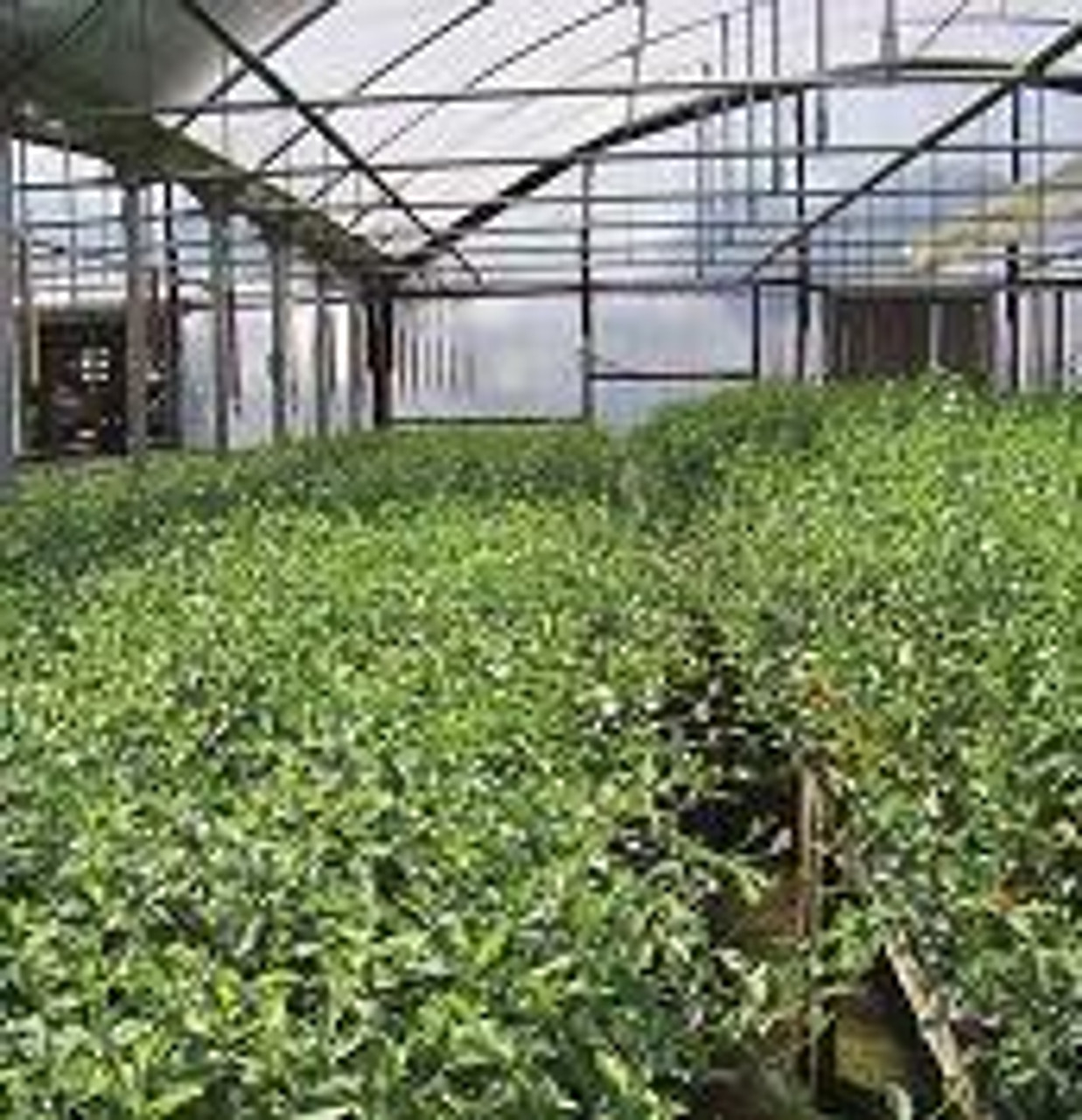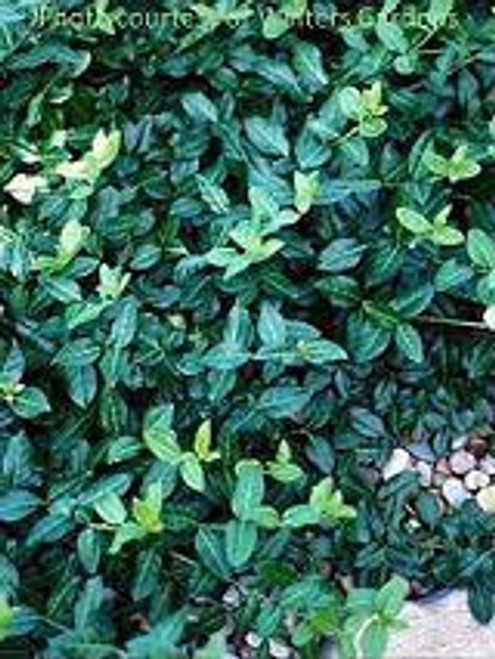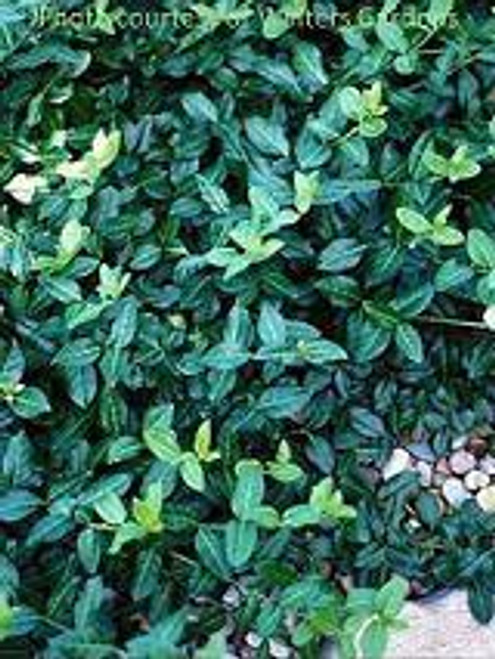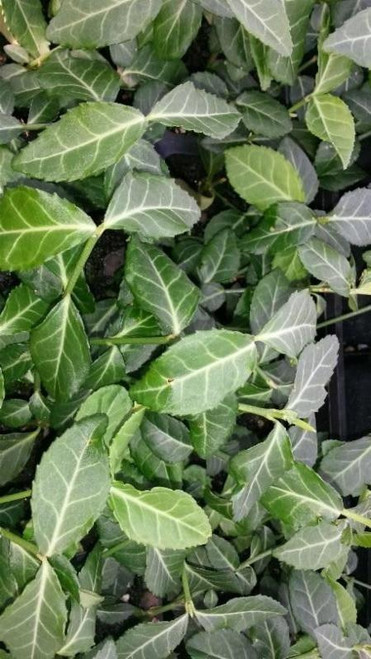Product Description
Euonymus fortunei 'Coloratus' (2.5-inch pot)
Common Name: Purple Wintercreeper
- Mature height up to 2', spread 3', climbs 20'
- Hardiness Zone: 5-8
- Full Sun to Shade
- Tough Ground Cover
- Leaves turn Burgundy in Winter
- Best used in areas where it can be managed.
- Keep pruned to 8"-12" for best ground cover look
- Use for large hard to cover areas.
Euonymus fortunei 'Coloratus', also known as Purple Wintercreeper, is an evergreen groundcover that is native to East Asia. It is a fast-growing plant that can reach a height of 6-12 inches and a spread of 2-4 feet. The 1 1/2" to 2" leaves are dark green in summer and turn a deep purple in fall and winter. The flowers are small and inconspicuous. It is tolerant of a wide range of conditions, including full sun to partial shade, moist to well-drained soil, and a variety of pH levels. It is also deer and rabbit resistant.
- Tough ground cover that will grow in most any condition.
- Excellent for erosion control.
- Rapid growth habit.
- Tolerates any well drained soil conditions.
- Drought tolerant once established.
- Euonymus 'Coloratus' will climb low walls.
- Not a good choice for a groundcover with shrubs due to its climbing nature.
- Water regularly, first year after planting.
- Fertilize lightly in spring or fall.
- Prune in late winter or early spring to maintain the desired shape.
Add a Splash of Year-Round Color with Purple Wintercreeper!
Euonymus fortunei 'Coloratus', commonly called Purple Wintercreeper, is a versatile and vigorous evergreen groundcover known for its rich, dark green foliage that transforms into stunning shades of purple and red in the fall and winter. This adaptable plant thrives in a variety of conditions, making it an excellent choice for adding color and texture to challenging areas in your landscape.
'Coloratus' is a cultivar of Wintercreeper Euonymus, appreciated for its vibrant seasonal color change. In the warmer months, it features lustrous, dark green leaves that create a lush, dense groundcover. As temperatures cool in the fall, the foliage transitions into beautiful shades of purple and red, adding a dramatic touch to the winter landscape. 'Coloratus' is a vigorous grower, spreading quickly to form a dense mat that effectively suppresses weeds. It can also climb if given support, making it a versatile choice for various landscape applications.
- Mature Size: 6-9 inches tall, spreading indefinitely
- Leaf Color: Dark green in spring and summer, turning purple and red in fall and winter
- Growth Habit: Trailing, spreading groundcover; can climb if given support
- Light Needs: Full sun to full shade (tolerates a wide range of light conditions)
- Soil Needs: Adaptable to various soil types, prefers well-drained soil
- Hardiness Zones: 4-9 (USDA)
- Special Features: Evergreen, vibrant winter color, weed-suppressing, erosion control, adaptable, low maintenance
Planting:
- Timing: Plant in spring or fall for best results.
- Location: 'Coloratus' is highly adaptable and tolerates a wide range of light conditions, from full sun to full shade. It performs well in areas with at least partial sun but can also thrive in deep shade.
- Soil Preparation: While adaptable to various soil types, amending the soil with compost or other organic matter will improve drainage and fertility, leading to healthier growth.
- Spacing: Space plants 18-24 inches apart for a dense groundcover. Closer spacing will result in faster coverage.
- Planting Depth: Plant at the same depth as the nursery container.
- Watering: Water thoroughly after planting and regularly until it is established.
Care:
- Watering: Once established, 'Coloratus' is relatively drought-tolerant, but it benefits from consistent moisture, especially during hot, dry periods. Water deeply but infrequently.
- Fertilizing: Fertilize in spring with a balanced fertilizer to promote vigorous growth. Avoid over-fertilizing.
- Pruning: Prune in late winter or early spring to control spread, maintain shape, or rejuvenate growth. Regular trimming can help prevent it from becoming invasive.
- Mulching: Apply a layer of mulch around the plants to retain moisture, suppress weeds, and protect the shallow roots.
- Pest and Disease Control: 'Coloratus' is generally pest and disease resistant. However, watch for common garden pests like scale insects or euonymus caterpillars.
Uses in the Garden:
- Groundcover: Ideal for creating a low-maintenance, colorful groundcover in a variety of locations, including slopes, under trees, or in challenging areas.
- Erosion Control: The dense root system helps stabilize slopes and prevent erosion.
- Foundation Plantings: Can be used as a low-growing foundation planting around homes or other structures.
- Climbing Vine: Can climb walls, fences, or trellises if provided with support.
- Containers: Can be grown in containers, adding a splash of color to patios and balconies.
Bring vibrant color and texture to your garden with the adaptable and easy-care Euonymus fortunei 'Coloratus'!
Other Details
The most important part of the plant is its root system. Healthy roots are the foundation of a healthy, vibrant plant. The type of plug container used is based on the specific needs of the plants. Perennials offered as bare root traditionally perform better when planted as bare root.Planted in a specialized mix, potted plants have well established root systems. Top growth stage will vary depending on the current life cycle and time of year when shipped. In Winter and early Spring dormant plants may be shipped. Dormant plants may be planted right away, even before the last frost date.
Most bare root varieties are field grown for at least one season, though Hemerocallis and Hosta are grown for two seasons. The bulk of the soil is removed during the harvesting process and the tops of most varieties are trimmed back to the crown. They are graded, packed in shredded aspen or sphagnum moss and stored in freezers until ready to be shipped.
See our Container Sizes and Bare Root Perennials pages for more information.
Plant information and care is provided in the Overview section, Plant Genus Page and general information is provided in the Planting Care & Guides. Additional questions can be asked on each Plant page.
Plant Spacing: Using the maximum mature spread or width of a plant to guide spacing, ensures space to grow to full size. To fill an area sooner, plant them closer together. Just remember, future thinning or transplanting may be needed.
Water: Keep a close eye on newly planted perennials, especially throughout the first growing year. Most early plant loss is due to too much or too little water!
Product Videos
Custom Field
Product Reviews
1 Review Hide Reviews Show Reviews
-
Great plants
My plants arrived with well-moistened soil. Unfortunately, I couldn't plant them immediately due to the insane weather alabama has been experiencing. I put them in a window & water them periodically. They're sprouting everywhere! I will most DEFINITELY buy from this company again.




















